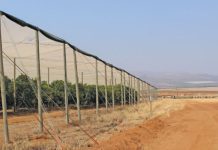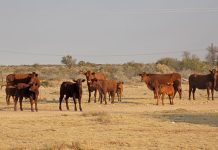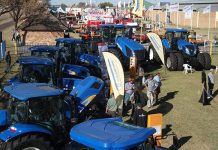When farm developers Pat Robinson and Guy McCormack bought a dairy farm in Lidgetton in the KwaZulu-Natal Midlands from Willie Pretorius’s family in 1991, Willie stayed on as manager and partner. With 120 cows at the time and only 80 in milk, it wasn’t a very difficult job. But that’s all changed and Willie is now clocking up 16-hour working days, overseeing 1 500 high-production Holsteins of which 700 are in milk. A pasture master, Willie is making progress with his plan to cover the entire 462ha farm with a bed of kikuyu.
“The conditions weren’t suitable for growing maize for silage, so we have to make grass work,” he says. “We can produce fantastic grass here and we have to exploit that.” Kikuyu silage is an important component of the dairy’s winter feed. “Kikuyu is a firm base which the cows don’t compact,” Willie explains. “It forms its own ecosystem and keeps the soil friable. It retains water well and in winter, we only need to irrigate at about 10mm a week.” The experimenting factor Willie is constantly experimenting with interplanting kikuyu with other grasses.
Last year, he planted ryegrass and stooling rye into rainfed kikuyu. This year, he experimented with planting Japanese radish into rainfed kikuyu. Immediately after the last silage cut was removed, Willie planted the radish with a Connor Shea no-till planter and grazed it at the full leaf stage. “The radish is looking good,” he says. “I didn’t expect it to last longer than one grazing, but it has. As long as the cows only thin it out and take the tops off, it grows back beautifully. If the cows eat it too low, it’s finished.”
He explains that the radish also shades the young pasture. Willie’s goal is to get combinations of grasses that will grow for 12 months. To this end, he’s started over-planting perennial ryegrass, annual ryegrass and clover into kikuyu. “This has bolstered the kikuyu and is making mulching less necessary, as the cows tend to graze the pasture much shorter and more cleaner due to the ryegrass’s palatability. “There’s also no run-off from the pasture.
That’s worth a lot in terms of soilwater retention and also makes better use of the annual rainfall.” Willie has had hits and misses overseeding annuals and planting with a no-till planter. The annual ryegrass has seemed more susceptible to wrong timing. With perennials in the mix, there’s already a perennial ryegrass component from the previous year, so it guarantees the winter crop with the fresh drilling of perennials and annuals. ccording to Willie, this increases the dry matter yield for the season, and has secured grazing for 12 months of the year for the past four seasons. Italian annual ryegrass is planted into kikuyu in September on dry lands or where pasture is sparse.
The seeds planted into the dry soil germinate when the rains come and grow through the kikuyu before the kikuyu dominates. This dramatically improves pasture quality. lot of pasture management comes down to gut-feel, Willie admits. “Every year is different and timing is important. If it starts to feel a little chilly, I know kikuyu growth will slow down, so it’s time to interplant. If the autumn is wet and warm like this season, it lends itself to rainfed over-sowing of crops like radish and stooling rye.”
Pastures that “yield” milk The key to milking off grass lies in developing pasture mixes that yield high biomass of palatable dry matter and grazing them when the quality is best and biomass is high. “We stop irrigating land at least a week before grazing. Dry matter intake and drinking water availability, the cheapest form of nutrition, will always be areas I focus on,” Willie says. Making sure the cow is full is crucial. “A full cow will always milk,” he says. “I would rather milk 700 full cows than 1 000 cows that are short of grass. Normally the 700 cows will out-yield the 1 000.” Willie has a no-till approach. “After the cows have gone through a pasture, we clean up by mulching and leave a lot of organic matter on the field.
As a result, the earthworms come back, followed by the moles whose burrows aerate the soil and help retain moisture.” Willie applies two topdressings of slurry and has seen good results, fast.F“Fertiliser costs are going through the roof and dairy slurry is an incredible resource that we have right under our noses. To stay competitive, we have to utilise what we have. We get in a contractor to pump slurry 51,5km to thefurthest pastures and pump the closer land with our own equipment. Our poorest fields have now become our best fields with no fertilisation.” Fertilisation consists of 140kg/ha of 16:1:3 after every grazing, trickle feeding the phosphate and potassium. Lime is applied annually.“ Milk is priced at the most efficient cost structures,” says financial partner Guy.
“If you’re not on top of your costs, you won’t survive. You have to get the basics right, including good general farming practice, fertiliser and irrigation, capacity and milk quality. Then you have to keep challenging conventional processes and methods. If you don’t, how will you ever know what you can achieve?” Contact Robinson & Pretorius on (033) 234 4348 or e-mail [email protected]. |fw
A top team that works
Robinson & Pretorius took third place in the Natal Master Dairyman Awards in April. The dairy attributes this achievement to teamwork, diverse skills and getting the basics right. Manager and partner Willie Pretorius says, “We all have our strengths and concentrate on improving our farming methods.
We never get complacent.” Partner Pat Robinson, originally a sugar and citrus farmer from the Eshowe area, has 54 years’ farming experience and has developed a shrewd ability to spot and correct weaknesses in the enterprise. The third partner, Guy McCormack, is a chartered accountant from Durban and runs the finance and planning side of the business.
Willie’s daughter Carike is the dairy manager, his wife Celia does the day-to-day bookkeeping and backs up general farm management, and farmer Ian Newton runs the heifers and dry cows on Brigadoon, a 427ha farm in the Dargle Valley. The dairy selects top-quality farm labour. “Each person is dedicated to doing his best and always adds that little bit extra to lift the standards of the farm work,” says Guy. “The workers receive incentives which are aligned to milk quality and low somatic cell counts.
Our premium for quality last month was R36 155.” Willie believes in utilising expertise from suppliers and service providers to help identify new trends and fine-tune the operation. His team of experts includes Meadows Feed technical manager Brian van der Bank, Paul Meade of World Wide Sires for breeding, Jacques Pretorius from Hygrotech Seed and vets Rodger Turner and Brian Taylor from the Estcourt Veterinary Clinic.
Look for good legs
Breeding is another area that Willie Pretorius specialises in and this has played a large role in the dairy’s achievements: 17 000â„“/day off 700 cows, or about 24â„“/day/cow. “By December, when our herd should have increased to 750 cows in milk, we’re forecasting 18 500â„“/day,” he says. Willie explains that he breeds for a well-balanced cow. “I breed for type, good udders that last and good legs, dairy strength and capacity.” He puts a lot of thought into which bull to use for breeding. “You can’t just rush in and use the bull of the day.
A bad choice of bull will cost three years – nine months of pregnancy and 24 months to raise the heifer to the point of calving.” Willie tends to use the top bulls available in small numbers – five straws at a time – as the price tag is high. “By the time the bull is older and his price drops, we’ll be milking some of his heifers and will already know how he works and what type of cows he works with. If the bull does well, we’ll use him more.” Cows last on average 3,5 to four lactations and this longevity has got buyers knocking on Willie’s door for his heifers.
But most of them are unlucky. “We’re building our herd and are not selling too many heifers. When we’ve reached optimum holding capacity of about 750 cows in milk, then we’ll sell the extra heifers.”








